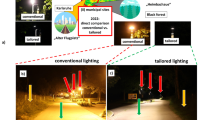Abstract
THIS phenomenon may sometimes be seen in this country when one's shadow falls on grass. It is not necessary that the grass should be wet, if the leaves have a shining cuticle; but the general direction of the blades (which grow usually more or less parallel to one another) in relation to the position of the sun at the time must be such that its rays strike their surface at an angle approaching a right angle. Under these conditions the blades of grass from which most light reaches the observer's eye are those upon which the sun's rays fall, and are reflected to him, most nearly perpendicularly, and the rays which do so are those which pass closest to his head without being intercepted by it. Hence there appears to him a ring of brighter illumination immediately surrounding the shadow of his head, the effect being heightened by contrast. Farther from the shadow, as the angle of incidence becomes more oblique, the luminous ring becomes gradually merged into the general illumination. The reason why the bright ring is not seen round the lower parts of the body or around the heads of other persons is that these are not so nearly in the direct line of incidence.
This is a preview of subscription content, access via your institution
Access options
Subscribe to this journal
Receive 51 print issues and online access
$199.00 per year
only $3.90 per issue
Buy this article
- Purchase on Springer Link
- Instant access to full article PDF
Prices may be subject to local taxes which are calculated during checkout
Similar content being viewed by others
Author information
Authors and Affiliations
Rights and permissions
About this article
Cite this article
PARSONS, H. Luminous Halos surrounding Shadows of Heads. Nature 90, 621–622 (1913). https://doi.org/10.1038/090621c0
Issue Date:
DOI: https://doi.org/10.1038/090621c0
Comments
By submitting a comment you agree to abide by our Terms and Community Guidelines. If you find something abusive or that does not comply with our terms or guidelines please flag it as inappropriate.



